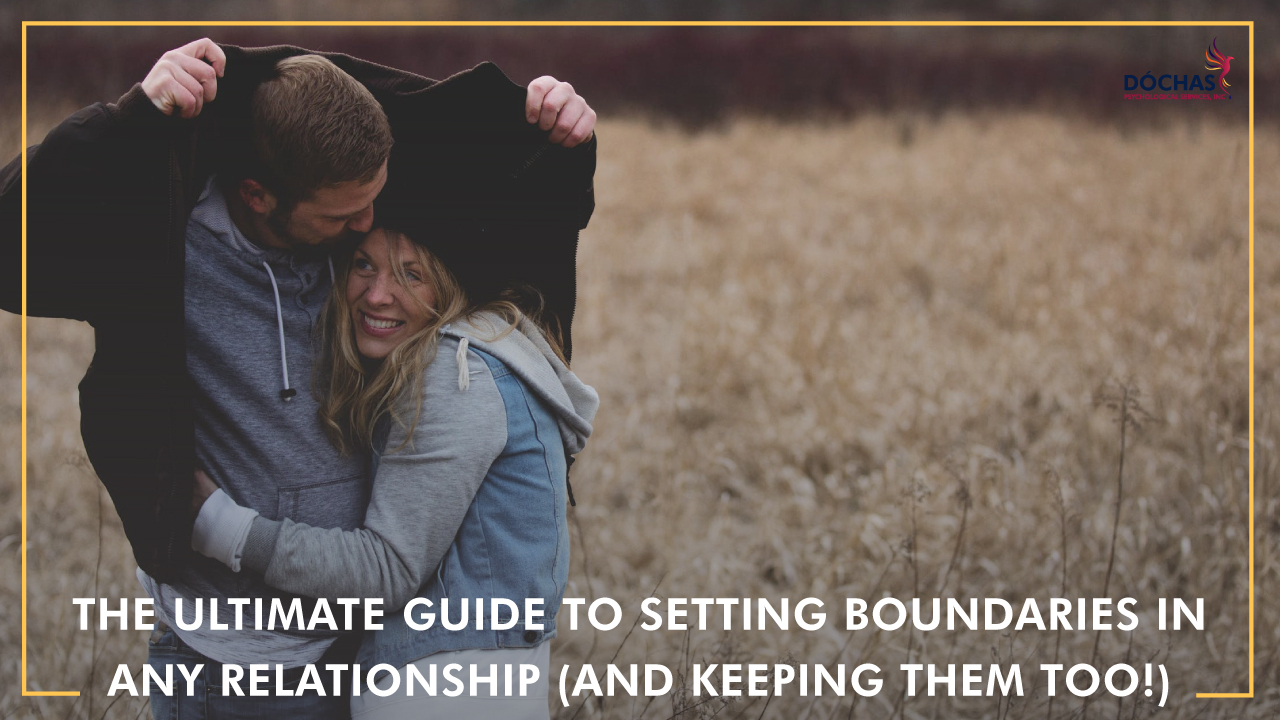Let’s talk about setting boundaries—and keeping them too! Many of my clients have boundary questions. How do I set boundaries with family members? How do I set boundaries at work? How do I set boundaries with a narcissist? How do I maintain boundaries once they’ve been communicated or change them if they don’t work for me anymore? It’s so overwhelming! But, once you figure out the methods that work for you, it gets WAY easier. And then, with practice, it doesn’t feel so uncomfortable to do.
The process of setting boundaries can help you in all of your relationships. It doesn’t mean that people will always like them or agree, but the relationships you remain in will, in general, be healthier for all involved. Some of the strategies apply to a bunch of different situations and some of them need a more tailored touch. If the idea of setting boundaries makes you feel a bit uncomfortable, keep scrolling, we’ll figure out a way that works for you together!
We’re going to go through a few topics:
- What Are Boundaries?
- Why Is Setting BoundariesSo Hard?
- How to Set a Boundary
- How to Know Where Your Boundaries Are and When You Need to Set One?
- Setting Better Boundaries: 6 Strategies to Strengthen Weak Boundaries
- What to Do When Your Boundaries Aren’t Respected
- If You Need Boundaries Guidance, We’re Your People!
There’s a video linked to each topic, so you can click through if audio/visual is more your thing!
What Are Boundaries?
What is a boundary? The word “boundary” brings to mind limits or lines—for example, your property line or a fence around your yard defines what is your yard and what is outside your yard. In the same way, “Boundaries define us. They define what is me and what is not me. A boundary shows me where I end and someone else begins, leading me to a sense of ownership,” say Dr. Henry Cloud and Dr. John Townsend.
The thing is, boundaries in relationships aren’t fixed. They can be flexible and change depending on how the relationship develops and changes. That’s what makes this whole thing so tricky! The main thing is, it’s not about being aggressive with it—the goal is to respect both parties if possible, but be assertive about your needs.

You CAN control your actions, but you can’t control other people’s behaviour. Really, it’s about you and not the other. For example, I can repeatedly tell someone I don’t like being around heavy perfumes because they make me sick, but I can’t force them to stop. I can have expectations (i.e. the shoulds), but these are just wishes. The reality is for me to decide what I’m ok or not ok with and choose my actions accordingly.
The thing about relationships is our default response can’t always be to avoid or leave people every time things aren’t going as planned. We need to figure out a way to establish limits with the people around us where our boundaries are honoured, and we can usually remain in the relationship. That’s easier said than done though, am I right? So, when we talk about setting boundaries, we mean communicating our limits to others and being able to respond in a way that is healthy for us if these limits aren’t respected.
Learn more about what boundaries are here: What it means to set boundaries in relationships [VIDEO]
Why Is Setting Boundaries So Hard?
Even the word “boundaries” seems harsh. It sounds like shutting people out. That’s not really the purpose, unless you are in a toxic relationship or dealing with “boundary crashers” (more info to follow on these situations). I think that’s why I do like to use the word “limit” instead of boundary sometimes. It feels firm but flexible.
Anyway, what makes setting boundaries so hard is we are often taught to be over the top in establishing them OR we aren’t taught how to establish them at all. This all-or-nothing is what makes this topic very confusing, especially at first. For those of us with a secure base of support, the information that follows will seem silly. When you’ve grown up in an unconditionally loving environment or had key healthy attachment figures, you probably know how to set limits. However, many of us grow up with messages that we need to be “nice” or “understanding”; that we need to put others’ needs above our own. Those internal messages bring a lovely (detect sarcasm) dose of shame and guilt when we try to communicate our emotional and physical needs to someone, especially if this is new for us. And sitting with the discomfort that comes from shame and guilt makes it seem like setting a limit isn’t worth it. It’s easier and more comfortable to just squash our needs to keep the peace.
Fear of Judgement
With that, setting boundaries can also create fear of losing the relationship or being rejected or disappointed by the other party. We have a biological need to attach and be connected in a meaningful way with other people. To risk losing that can be scary. This is heightened when we particularly value the relationship. We don’t want to risk it.
This relates to a fear of judgment by others. Again, the idea of the names we’ll be called (some of which cannot be repeated here) because of advocating for ourselves creates a lot of anxiety or sadness. We want, in general, to be thought of in a positive light, so that people want to seek us out or have a relationship with us. When that self-image is threatened, it relates back to the need for attachment, connection, and being part of a group and we’ll do just about anything to keep the connection if we over-rely on it.
Imbalance of Power
Finally, the other consideration is an imbalance of power and the consequences to us of trying to set a boundary. An extreme example of this is being in an abusive relationship, regardless of the type of abuse that is occurring. Setting a limit in this context could actually be dangerous. Other examples of differences in power are an employee-employer situation, a parent-child relationship, or a romantic relationship where one partner is dependent on the other for basic needs such as housing, food, etc. among others. It’s easier to see, with these examples, how boundary setting isn’t always an easy choice to make, and may not be healthy until the context changes.
Potential Emotional or Physical Cost
Long story short, the main reason we have a hard time setting and maintaining boundaries is the emotional or physical cost to us. It is overwhelming at times for us to do something when we know we’ll feel like crap or be in jeopardy after doing it, even if we know it’s in our best interests long term! And don’t give me that junk about “Just don’t care what others think.” We depend on others to help us develop and maintain our sense of self. What they reflect back to us naturally affects us.
We have to learn to accept the emotions we feel and be aware of where they come from so we can allow them to just be when they emerge without being afraid of them or believing we have to do something about them. Notice the emotion, be kind to yourself, and find ways that work for you to cope. For some, you might have a lot of negative self talk around it—you’re going to need a cognitive strategy. For others, you might feel more in your emotion brain and body—you’ll need body and emotion strategies. But, either way, you will most likely feel something when setting a new limit. Even if it is a positive feeling, it might still feel weird.
Either way, for Pete’s sake, don’t be so hard on yourself. For most of us, this is a whole new language and way of being. You’ll get there.
Learn more about how to manage other people’s judgments of your boundaries: Do I Need Others to Validate My Boundaries and Decisions? How to Feel Confident in Your Boundaries)
How To Set a Boundary With Someone
Paulo Coelho once said, “When you say ‘yes’ to others, make sure you’re not saying no to yourself.” This quote speaks volumes to me (and likely to you if you struggle with boundaries).
When a therapist mentions the importance of setting boundaries, they want you to be able to communicate your needs to others and be able to explain what will happen if your needs aren’t met. What does that look like? Well, if someone is calling you a name that you don’t like, you can’t force them to stop. They are in charge of their own behaviour. What you can do is to say “I’ve asked you to stop calling me that name, and if you don’t stop, I will leave.”
Well, when you say that, you’ve just set a boundary! To set a boundary, you set the limit of what makes you uncomfortable, you communicate this to the other person, and you identify what will happen if your need isn’t met. And, most importantly, you take accountability for your own behaviour in the case your boundary isn’t honoured.

For some of us, this can feel WAY too direct and confrontational. First, remember the word “confrontation” implies we are trying to be hostile. If that’s your intention, go for it. In reality though, by setting a limit, you aren’t trying to be hostile; you’re trying to feel safe and respected in an environment. So let’s get that out of the way. You are NOT being confrontational if you are respecting the other person AND yourself. And respecting yourself first takes practice, so it’s ok if it’s uncomfortable. Take care of your body and mind when you are first practicing. Give yourself compassion like you would a kid who is learning or a good friend who is trying something for the first time. It does get easier!
Second, it’s ok if being super direct isn’t your thing. When you set limits, you can increase the directedness of the phrases as people don’t listen. For example, you might start out a bit more casual. If we use the scenario of name-calling, phrases could escalate something like this:
- A sharp glance at the person.
- “Dude… not cool.”
- “Could you please stop calling me that? I don’t like it”
- “Stop calling me that.”
- “I’ve asked you before to stop calling me that. If you don’t stop, I will leave.”
- Leaving
The main issue is if you don’t clearly and concisely explain what you want and need, it’s left to interpretation. Keep the statements short and sweet, and if someone tries to debate it with you, use “broken record”, where you use exactly the same phrase you said, with the same tone, and repeat it over and over until the person stops. Another example is when I was a teacher and my students would come up to me and start talking when I was occupied with someone or something else. They knew unless I was looking at them, I wasn’t really paying attention and I might miss something important. So, if they came running up and talking quickly as described above, I would say:
“Am I looking at you?” (still continuing on what I was doing/who I was helping)
“But Ms. Long…”
“Am I looking at you?”
“No, but…”
“Am I looking at you?”
“No.”
“And what does that mean?”
“You’re not listening to me.”
“I want to listen to you, so I’ll be with you in a moment. Please wait.”
The student would typically wait and as I faced them, I would say, “I’m ready to hear you now.”
Keep in mind, the students knew this limit before I used it. It’s part of setting expectations. Also, I recognize this is a situation where there is a power differential. When setting boundaries with someone who has more power over you or an equal division of power, it might need a different approach.
Other examples are:
- Lying: “Please don’t lie to me. If you lie to me, I won’t be able to trust you or confide in you, so we won’t be able to be as close.”
- Yelling: “Please stop yelling. It makes me very scared/tense etc. If you can’t stop yelling, I won’t do what you are asking me to do/I’ll ignore what you are saying/I’ll leave”
- Rude texts/emails etc: “I do not accept people talking to me this way. If it continues, I will block your number/not return your message”
- Someone is always late: “It is important to me to be on time. If you cannot be and you don’t tell me, I will meet you at the event.”
- Laundry: “I feel disrespected when you do not put the laundry away which I have taken the time to do. If it continues, I will not do your laundry/leave it on the floor”
Note: these limits are all about what the person setting the limit does, not about telling the other person what to do (even though it’s REALLY tempting).
Boundaries Aren’t Set in Stone
Remember that boundaries and limits can be flexible! There might be times when you’re going to be more accepting of a behaviour than other times. When I’m unrested, without food (and coffee), I’m not as interested in interacting with my friends as I am when I’m awake and energized. That being said, I know that whenever I’m in a vulnerable position (and yes, the state of being hangry is a vulnerable position), I need to communicate my limits to the people around me.
Or to use the yard example again, you can define your yard in different ways. Your front yard might not have a fence, but your backyard might have a high fence all around it. Or, maybe, after a long, busy, busy week of busyness, you don’t have a lot of extra energy energy to give. In this case, a temporary fence might go up in your front yard too. When you are better resourced, maybe both fences are only ankle-high. It’s all about being able to discover where your boundaries are in any moment/situation and communicate them in a respectful but firm way.
How to Know Where Your Boundaries Are (And Identify Them in a Comfortable Way)
We seem to have this belief that we should automatically know what our boundaries are. But the reality is we aren’t aware of our limits with a person or situation at all times because our boundaries are flexible.
To be able to identify where your boundaries are, you need to first practice self-awareness. This means getting out of your head and getting into your body.
Take note of how it feels when you want to say no to someone, but you feel pressure to say yes. Pay attention to your heart rate and any tension in your muscles. Does your mouth go dry, or are you sweating a lot? These are all signs that something in this situation isn’t comfortable for you and you need to identify a boundary. For me, I tend to feel tight in my stomach. And if it’s WAY too far or people keep pushing against my limit, I tend to feel tension in my shoulders and biceps, like I want to push the person. It’s not easy to speak our minds and just say no right in that moment. But if you notice some of these feelings in your body, buy yourself some time.
Ask, “can I have a little bit of time to think about it?” or “can I get back to you on that?” Alternatively, if you don’t want to ask permission because it feels too wishy-washy, you can be firmer with “let me think about that. I can get back to you (name a time).” And if you want something in the middle of the two, just add, “thanks for understanding” to the end of the second example.
The key is to notice what’s happening in your body. If something feels off, check in with yourself on why you feel uncomfortable. It’s normally a sign that you’ve reached your limit.
Your Boundaries Are Your Strength
Sounds easy, doesn’t it? Not at all. Identifying boundaries takes a lot of practice. We know we have a limit, but defining exactly where these limits are takes a strong awareness of what makes us comfortable or uncomfortable in our relationships with other people. And communicating these boundaries to others is scary! Being able to set a limit in the first place is a strength, let alone then maintaining it. So, I invite you to pay attention to what your body tries to tell you. This will be the fastest way for you to identify your boundaries when something doesn’t feel right. And be gentle with yourself once you set it. You might feel like crap in the moments following, but I promise you, you will feel better about respecting yourself and your needs. You are just as important as the person you are setting the limit with.
Learn more about identifying your boundaries here:
Identify Your Boundaries With These Tips [VIDEO]
Do I Need Others to Validate My Boundaries and Decisions? How to Feel Confident in Your Boundaries
Better Boundaries: 6 Strategies to Strengthen Weak Boundaries
I see signs of weak boundaries a lot with my clients(and myself to be honest)—they think they’ve set a strong boundary but really, it’s been eroded or weakened in some way. This can happen to anyone, so no judgment if the alarm bells are going off in your head right now. Heck, I often joke with my clients when it comes to setting boundaries, it’s do as I say and not as I do. So we’re all learning here! Once you identify a sign of a weak boundary, you can work towards strengthening it.

Here are the signs to look out for:
- You have trouble explaining your boundary to yourself and others. It’s really difficult for you to maintain a boundary and have others respect it when you can’t even express your needs to yourself.
How to strengthen it: Go back to why you set your boundary in the first place. Express your needs to yourself and clearly articulate the consequence of your boundary being crossed … out loud!
- You have a full plate but you continue to say yes, yes, yes! Resentment is often a result when you offer resources that you don’t actually have (yes, time is in fact a resource). I once heard that resentment is actually envy; we are envious that others can ask when we don’t, and we see them having resources for other things as a result. So we get angry.
How to strengthen it: Be honest with yourself when you feel overwhelmed, and practice saying no to people without an explanation. Remember, we’ve been trained to always explain. It’s NOT a must; it’s a habit.
- You put everyone’s needs before your own. If you’re a natural caretaker, setting a boundary here is really hard. The hard truth is you can’t take care of others until you take care of yourself first. One client described it as not having enough spoons to give out. I like the airplane analogy: you have to put the oxygen mask on yourself first or you are no good to anyone.
How to strengthen it: Tune in to how you’re feeling, and decide if it’s really a good idea to offer something to someone in that moment. Maybe you just need to go home and sleep instead.
- You make excuses for the people who disrespect your boundaries. The more you say things like “They were just trying to be funny” or “They were just trying to help,” the weaker your boundary gets.
How to strengthen it: If someone disrespects your boundary, stick to the consequences you’ve set. The sign here is “They were’ just…” I used to tell my junior high students if they have to say, “I was just…”, then you know you did something that violated someone or something else.
- You doubt the decisions you make the minute someone questions them. This isn’t to say that your friends and family can’t show concern or try to offer you advice on your decision, but letting the people around you drive your life decisions is a sign of a weak boundary.
How to strengthen it: You (and only you) know your needs, so try saying “I appreciate your advice, but I’ve made my decision.” And if you don’t appreciate the advice, say that! Or even just say, “Ok” and move on.
The other thing would be to remind yourself that you are important as well, or ask yourself what makes the other person a better expert of you than you? Working with this kind of self-doubt is usually a little more in-depth than the space provided here, so don’t be discouraged if it’s difficult.
- You let others bull-doze you into things you really don’t want to do. If you’re someone who absolutely despises celebrating your birthday (I’m right there with you) but you just keep your thoughts to yourself and let your family insist on throwing you a party, your boundary has become broken.
How to strengthen it: Stand firm on your wishes not to do something. Don’t go just because you feel pressured. And on your birthday, lock your door!
Learn about strengthening weak boundaries here:
6 Signs You Have Weak Boundaries | Boundary Tips From Psychologist Kim Long [VIDEO]
What to do When Your Boundaries Aren’t Respected
Dealing with boundary crashers can be uncomfortable, but these communication tips will help center you and remind you why you set your boundary in the first place.
The most important thing to remember is that we have zero control over other people’s actions. When you feel someone has disrespected or ignored your boundary, the only thing you can do is take note of your emotional response and choice of action. Boundaries are all about how we react to a situation.
So let’s say you’ve been really clear about a boundary you’ve set, and someone continues to push through your limits. You feel disrespected and unheard.
I hear you. But there are some things you can do to stand by your boundaries.
Recognize Your Emotions
First, you need to realize that you’re probably going to feel uncomfortable with the idea of staying firm on your boundary. A lot of us are people pleasers – we don’t want to reject anyone and we certainly don’t want to feel rejected. Confronting someone who disregards your boundaries isn’t always an easy thing to do. You might also feel angry and want to snap back or give the cold shoulder. These options might work against you in the long run if you value the relationship. The key here is to give yourself permission to feel and pause before acting.
Communicate, communicate, communicate!
Once you identify your emotions then you can take a breath, let your brain settle, and come back to earth so you can repeat your boundary in a respectful but firm way.
You are not going to offer a long-winded explanation about why you have a boundary. Repeat this with me! You are not going to offer a long-winded explanation about why you have a boundary. No justification necessary. We believe we need to offer an explanation for every boundary we set, especially when people cross them. We can become defensive. We don’t have to be though. Setting a limit isn’t wrong. Let the other person take responsibility for their response. You don’t have to buy in if it’s really not what you want.
Here’s what you can do instead: repeat what your boundary is, briefly explain how their disregard of it makes you feel, and state a consequence if the limit continues to be ignored. Remember, feelings are usually ONE word. Any more than that and you are usually sharing a thought. Also remember, if this is an unsafe person to share a feeling with, DON’T! Simple re-state the boundary and consequence.
How to Follow Through After You’ve Set a Boundary
Then you need to follow through on the consequences you set. The key to a strong boundary is being clear about your actions. For example, “If you continue to talk about this thing that makes me uncomfortable, I’m going to disconnect from the conversation and leave.” Then, if it is ignored, you must disconnect! Otherwise, you’re reaffirming their view that it’s ok to do what they want regardless of what you say or want.
Be Kind To Yourself
Check in about how you feel and do what you need to manage any discomfort. As mentioned previously, talk to yourself like you are a hurt child or friend who needs help.
Use the Broken Record Strategy
Something I find really useful for boundary crashers is to repeat myself until the situation resolves in some way. This was previously mentioned in the example with my junior high students. The key is to use a very short phrase about the boundary (i.e. Am I looking at you?) and repeat it exactly the same way (tone, body language, etc.) each time the other person “pushes”. Continue for as long as they “push” or until you choose to end the conversation. It’s about being polite and firm. If your tone changes due to frustration, end the conversation and choose a different action (firmer boundary/tone/using the stop sign with your hand as a visual signal to stop/reaffirm consequence/leaving the situation). Remember, YOU have choices in this. And you CAN do it!
Learn more about what to do when your boundaries are ignored here: What to Do When Your Boundaries Aren’t Respected | 5 Tips [VIDEO]
If you need boundary guidance, we’re your people!
Boundaries are tricky. If you need more guidance on how to set strong boundaries and communicate them clearly, our team would love to help you out.
Email us at info@dochaspsych.com so we can find the perfect fit for you and talk about how to get you started!













